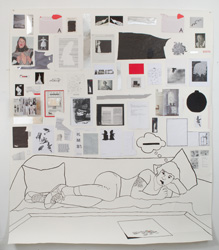Frances Stark, Subtraction, 2007.
Born 1967 in Newport Beach, California; lives in Los Angeles, California
Since the 1960s many American artists have incorporated text into their work, but for Frances Stark language is not so much an aspect of her production as it is an essential and symbiotic other half: her earliest career intention was to become a writer, and she remains one as much as she is a visual artist. “There is a fight in my work,” she notes, but this is a struggle that profits both sides. Her published writing, ranging from quasi-autobiographical narrative musings to aphoristic essays, is marked throughout by a keen visual acuity, while her art presses language into service as medium and subject.
Perhaps not surprisingly, the recurrent motifs of Stark’s work evoke writing and the activities that often accompany it—from cutting, copying, repeating, and citing to the quotidian realities of sitting at a desk and reading the mail—as do her materials: carbon paper and rice paper, ink, and linen tape. Fragments of language, from blocks of repeated typewritten letters to passages by writers including Emily Dickinson, Henry Miller, and Robert Musil, are arranged on white paper fields in both abstract patterns and recognizable forms including furniture, flowers, and animals. In and In (2005) features dozens of strips of junk mail spliced together and “stacked” in two zigzagging towers as if piled atop a desk: it is a conflation of art space and work space whose subtle allusion to the increasing corporatism of the art world is tempered by its intricate polychromatic delicacy.
Stark draws on Conceptual art and Minimalism as key sources. Certain of her works recall the spare poetics of Carl Andre; one project, The Unspeakable Compromise of the Portable Work of Art(1998–2002), engages a 1971 essay by Daniel Buren. While other a≈nities occasionally surface—to predecessors as diverse as concrete poet Tom Phillips and high-Cubist-era Pablo Picasso— the sociopolitical imperatives of the 1960s and 1970s underpin much of her work. Stark’s birds and flowers are not simply signifiers of production and inspiration: they are traditional markers of the female. The projected PowerPoint work STRUCTURES THAT FIT MY OPENING AND OTHER PARTS CONSIDERED IN RELATION TO THEIR WHOLE (2006) similarly reveals her sensitivity to the exigencies of her position as a contemporary woman artist and writer. An epigrammatic collage of her own writings and excerpts from others, its dry boardroom format enlivened by intermittent bursts of sound, color photographs of her home, and images of her art, the work is a moving, personal rumination on “what kind of ‘liberation’ I—as a woman, artist, teacher, mother, ex-wife—am really after.” LISA TURVEY
Frances Stark, Subtraction, 2007. Ink on paper inlaid with found printed matter, 92 x 80 in. (233.7 x 203.2 cm). Private collection
























